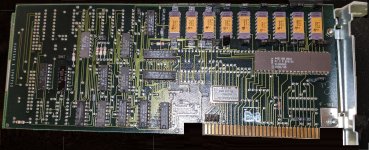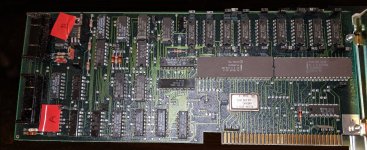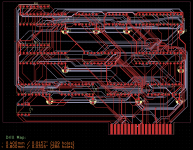Hello,
Yesterday I made some advances:
- Found what component the CPU uses to generate /IORD, /IOWR, /MRD and /MWR. From there it is only a matter of time that by following /IOWR and /IORD all ports become known.
- By studying the code, I found the CRT controller initialization routine and with it its ports: 0x45 for commands and 0x44 for attributes. This means I could initialize the controller, but without the DMA still couldn't fetch the video data.
- Not only found the basic commands strings in rom 02h, but also found every single rom contains its P/N within the code and a notice of copyright. Mine has notices from 1980 and 1982. The code starts after those strings and there is apparently no fixed address for them to be.
- All strings are in EBCDIC, of course.
- IBM used lots of illegal instructions in their code, I imagine both to have functionality and to bother any disassembly attempt.
On the development side I have three designs to deal with ROM and RAM failure. After they are fully revised, prototypes will be ordered and if they work fine this kind of Datamaster failures will be a thing of the past.
I have been able to see some 32KB DRAM boards and they seem to contain the same integrated circuits as my 64KB one. Just the half of them and no buffers. If I could document them I would be able to kill once and for all the myth of redundancy.
By the way, I imagine some may have already been asking themselves how to properly have this computer in a bench... actually to make it possible, an ATX PSU can be easily rewired to the 12 pin connector of the Datamaster board. For the video, a composite adapter is the way to go:
It can be a bit tricky to find a screen that supports it but at the end it is possible.
View attachment 1276544
I am not sure at which frequencies does the Datamaster generate its video, but I am starting to suspect we could have an early version of MDA here. Making an adapter would be trivially easy knowing most of the pinout (let's be honest - it would be easier than what I have done here).
Every time I watch the 5150 and its original expansions the more I see the System/23. Some things were dropped such as the video controller, the DMA was overhauled, the CPU was replaced and the bank registers were dropped because the CPU handled it its own way. Maintained the same 12 pin connector in the prototype, the TMS4132 in the 64KB expansions and the MK36000 for the BIOS. It may be just more than an influence to the PC but the base for their first prototype where they would go replacing or removing subsystems. That would also explain how they could get it in a year instead of three.
Regards,
Jaume





